Click to go to the language version:

 [This function doesn't work on app]
[This function doesn't work on app]
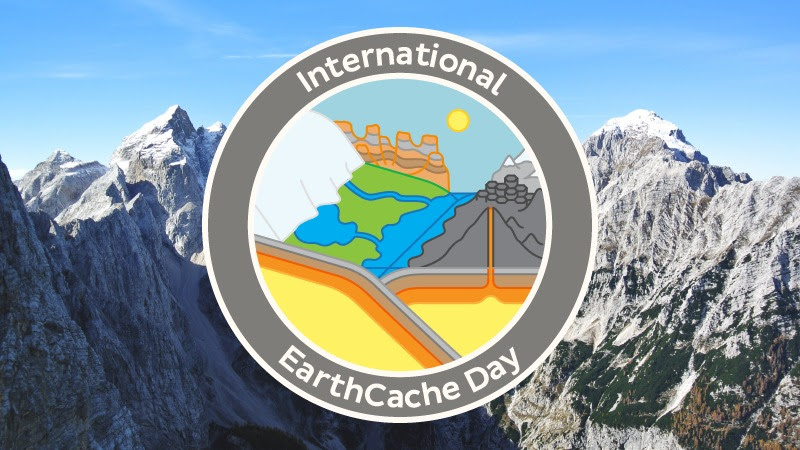
Skrzynka założona z okazji International Earthcache Day 2016

Kimkolwiek jest architekt budynku przy ul. Olesińskiej 2, na pewno ma świetny gust w wybieraniu fasad swoich projektów.
To dzięki niemu może powstać ten Earthcache.
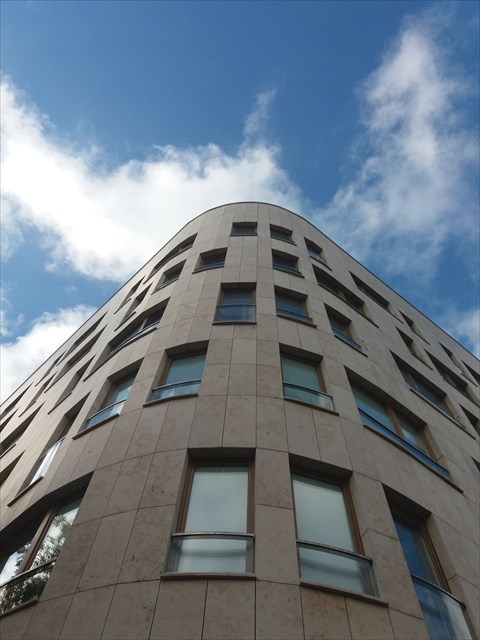
Współrzędne startowe zaprowadziły Cię na róg ul. Puławskiej i ul. Osińskiej. Tuż koło Ciebie stoi budynek obity beżowym kamieniem. Jak już się domyślasz nie jest to zwykła ściana. Przed tobą znajduje się niezwykłej urody wapień jurajski, ale nim zdradzi Ci on wszystkie swoje sekrety pozwól, że Cię wprowadzę w tematykę tej skrzynki.
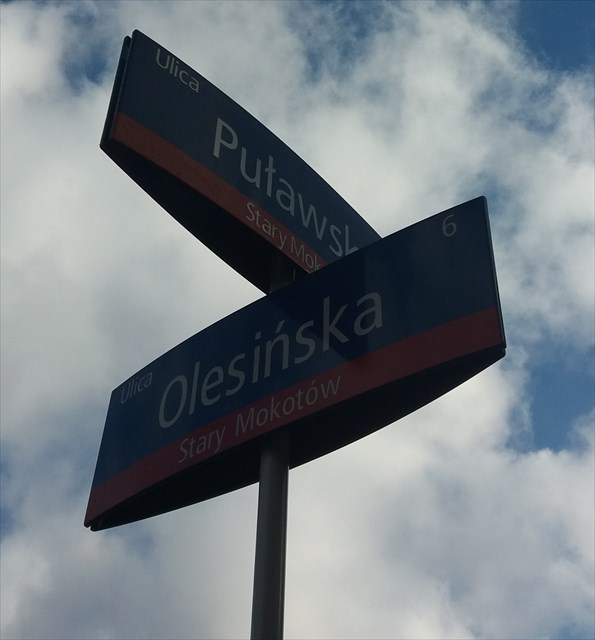
Jest 160 mln lat przed nasza erą. Świeci słońce, jest 40 stopni w cieniu, przed tobą morze. Pogoda jest istnie plażowa.
Odłóż ten parawan - nie przyda Ci się.
Przed tobą morze, za tobą morze, po bokach morze, sam widzisz, że nie ma gdzie go rozstawić. Obawiam się, że najbliższa czynna plaża (oczywiście niestrzeżona) znajduje się setki kilometrów stąd.
Zapewne zastanawiasz się skąd tu tyle wody? Otóż naukowo udowodniono, że dinozaury nie korzystały z ekologicznych samochodów, ani nie montowały energooszczędnych żarówek. Wiadomo jak to się musiało skończyć, lodowce stopniały i zrobiło się bardzo ciepło.
Po więcej sensacyjnych opowieści o tamtejszej epoce odsyłam Cię do internetu (tam znajdą się eksperci którzy profesjonalnie przedstawią Ci tamte wydarzenia), teraz czas na zejście pod wodę...
Gotów? Weź głęboki oddech i powoli zanurz się w toń...
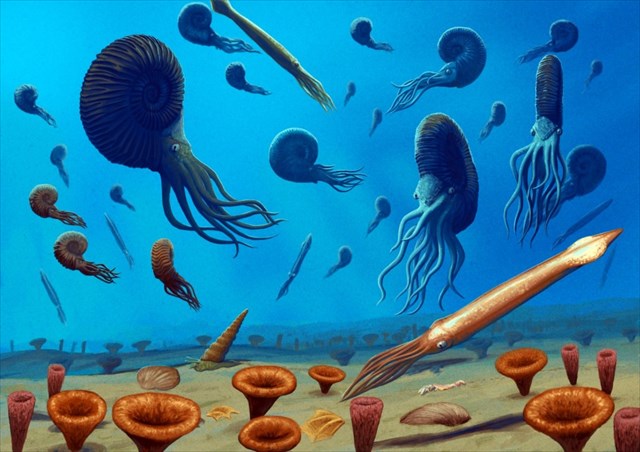
W ciepłych wodach morza szelfowego kwitnie życie.
Praktycznie wszystko co w niej pływa, ma taką konkurencję, że musi toczyć nieustanną walkę o przeżycie.
Przed tobą unosi się setki amonitów. Te drapieżne głowonogi słyną ze swych charakterystycznych spiralnych skorup.
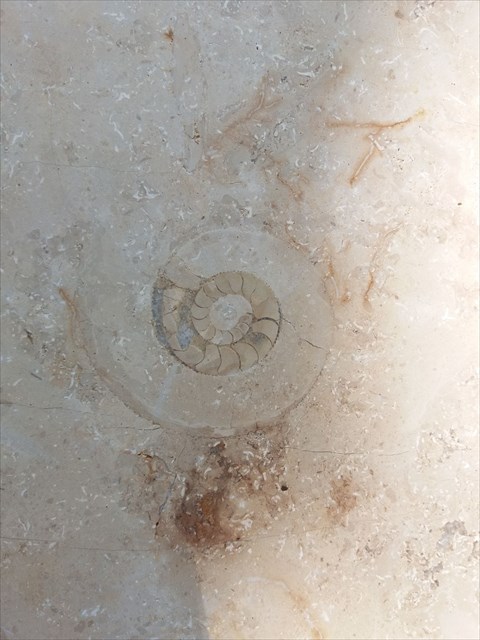
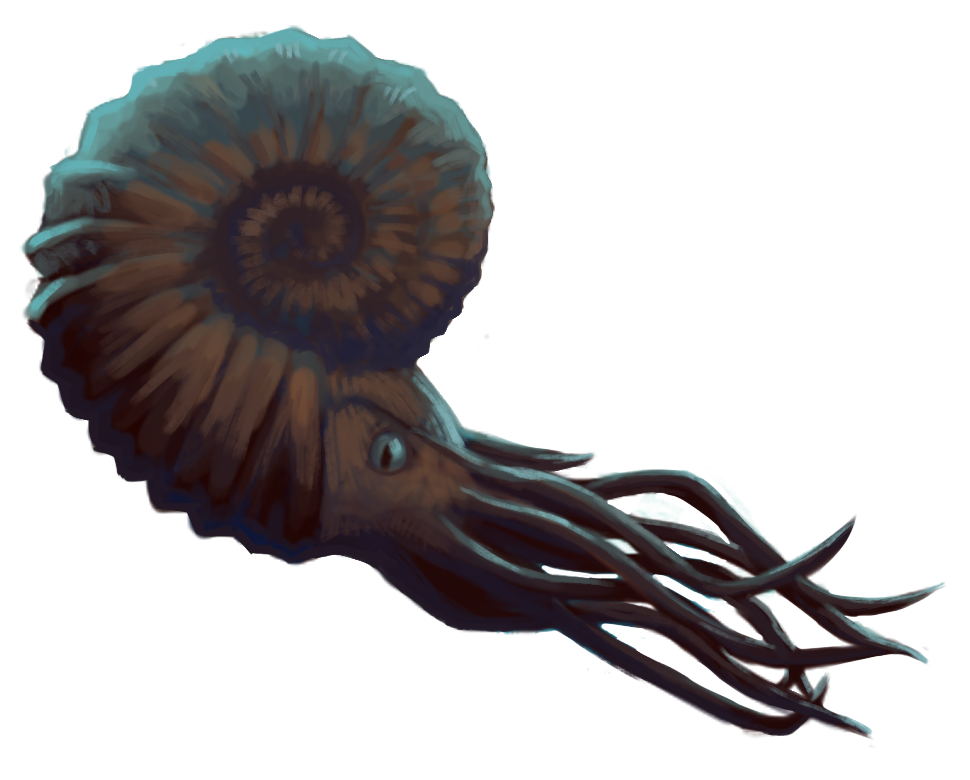
Amonity
W wodzie poruszają się też dziesiątki podłużnych belemnitów, dziś zostały po nich tylko fragmenty szkieletów.
Rostrum (bo tak fachowo się je określa) bywały kiedyś błędnie nazywane "strzałkami piorunowymi". Sądzono, że są one stopionym przez piorun piaskiem (takie strzałki też istnieją - nazywają się fulgurytami).
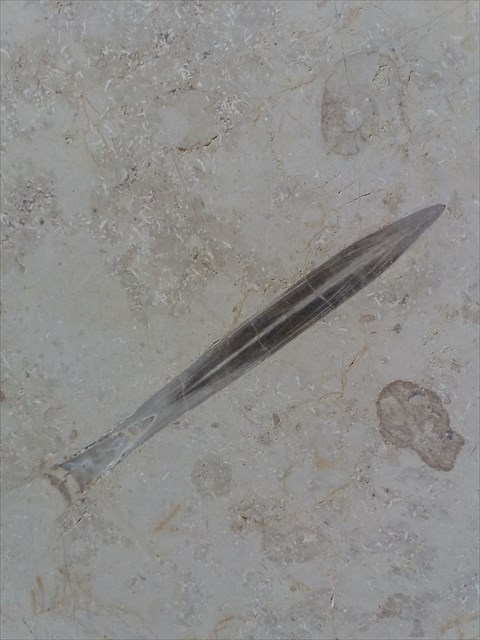
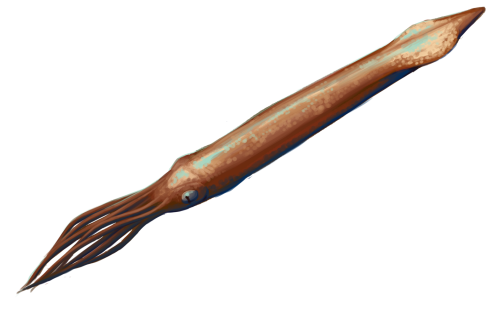
Belemnity
Na morskim dnie królują gąbki. Ich życie nie różni się zbytnio od ich dzisiejszych potomków. Zwróćcie uwagę, że zazwyczaj mają one kielichowaty kształt - ich skamieniałości będą przekrojami stożków (co wynika z pocięcia wapienia na płyty) np. okręgi czy otwarte trójkąty.
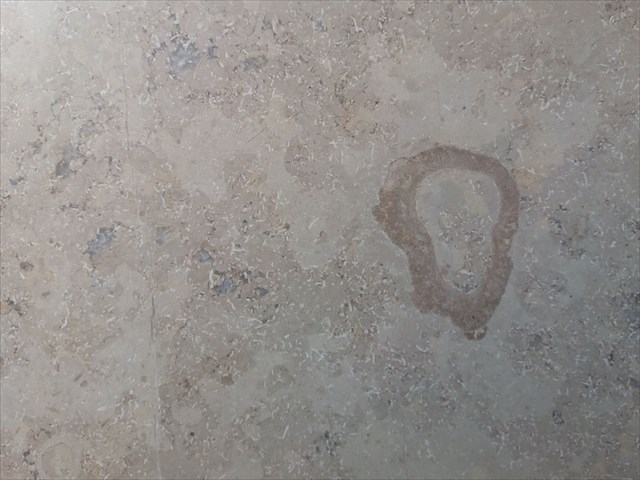
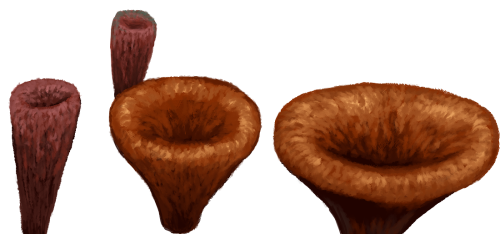
Gąbki
Prócz wyżej wymienionych zwierząt, w naszym morzu żyją także ślimaki, małże czy krewetki (te ostatnie nie pozostawiły po sobie skamieniałości, lecz można zaobserwować małe jamy - drążone przez nie w miękkim wapiennym dnie).
Twoje zadanie:
By móc zalogować tę skrzynkę musisz najpierw wykonać kilka zadań opisanych poniżej. Zebrane odpowiedzi wyślij mi proszę w wiadomości prywatnej (message center).
Stoisz na współrzędnych startowych?
Odwróć się twarzą w głąb ul. Olesińskiej, po prawej stornie znajduje się 5 kolumn (waypoint "Zadanie 1"). Ponieważ powierzchnia całego budynku jest strasznie duża, ustalmy te kolumny naszą powierzchnią badawczą.
Twoje zadanie jest proste, zbadaj dokładnie powierzchnię wszystkich kolumn i policz ile amonitów i belemnitów się na nich znajduje. Przy amonitach licz tylko okazy większe niż 3 cm (nawet jeśli jest to tylko cień spirali).
Czy widzisz na nich jakieś gąbki?
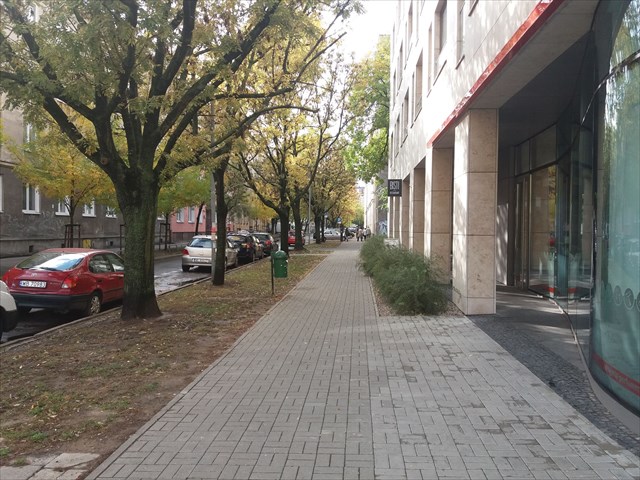
Zadanie 1
Udaj się teraz na waypoint "Zadanie 2". Znajdujesz się teraz na ul. Puławskiej. Od frontu budynku (na poziomie przeszklonej drogerii) znajdują się kolejne 3 kolumny. Oceń na której z nich (lewa/środkowa/prawa) jest najwięcej skamieniałości. Która z nich jest twoim zdaniem najpiękniejsza?
Przejdź teraz na waypoint "Zadanie 3" - stań na ścieżce koło budynku i popatrz w górę.
Na prawo od okien znajduje się duża "pusta" ściana. Słowo "pusta" nie jest tu do końca trafne - jak wiemy jest tam wiele skamieniałości.
W której kolumnie (licząc od prawej) znajduje się płyta z dużym (prawie białym) amonitem? Czy widzisz jeszcze jakąś ciekawą skamieniałość? Jaką?
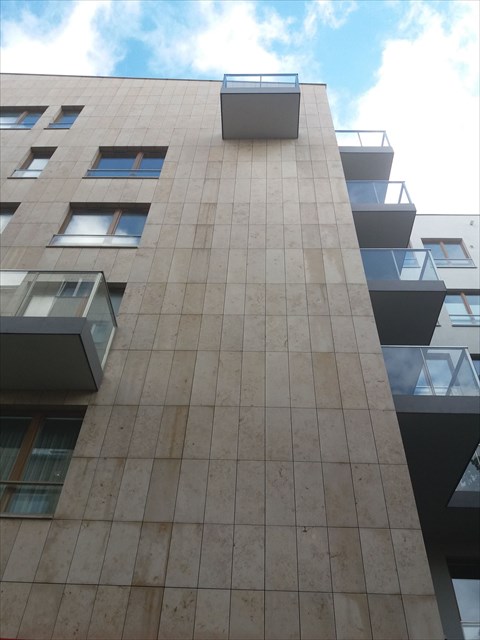
Zadanie 3
Ostatni punkt znajduje się przy waypoitcie "Zadanie 4". Znajdź drzwi ewakuacyjne ze sklepu. W miejscu zaznaczonym czerwoną strzałką (patrz zdjęcie) znajduje się belemnit - oszacuj jego długość.
W którą stronę by płynął gdyby żył (góra/dół)?
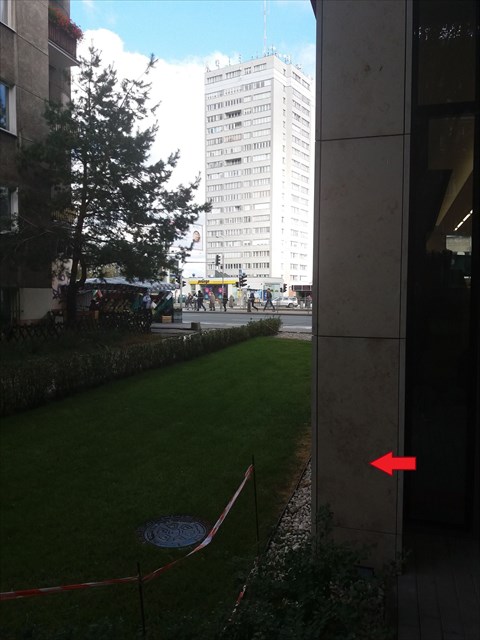
Zadanie 4
Zadanie 5 (dla chętnych) - te skamieniałości są naprawdę piękne, podziel się we wpisie swoimi zdjęciami.
Special thanks to haniagaj for the English description ;-)

Whoever the architect of the building at 2 Olesińska Street was, one thing is for certain: he had excellent taste inchoosing facade materials for his buildings. It is thanks to him that we could create this EarthCache.

The starting coordinates brought you to the corner of Puławska and Olesińska Streets. You are now standing next to a building covered in beige stone. As you probably suspect, this isn't just any ordinary stone: it is exceptionally beautiful Jurassic limestone. But before it reveals its secrets to you, let me to introduce you to the subject of this cache.

It is 160 million years ago. The sun is shining, the temperature is over 40ºC (100ºF) in the shade, and the ocean spreads out before you. Beautiful beach weather. But put away that beach towel – you won't be needing it. There is water all around you, the closest beach is many miles away, and it doesn't even have a life guard. You're probably wondering where all this water comes from. Well, it has been scientifically proven that the dinos didn't use electric cars or energy efficient light bulbs, so you know how it had to end: the glaciers melted and it got very warm. For more sensational news from that era, I refer you to the Internet, where you will find many expert articles on the subject. For us, it is time for a dive. Ready? Take a deep breath and slowly descend...

The warm waters of the shelf sea are teeming with life. Practically everything that lives here has so much competition that it has to constantly fight for survival. All around you, there are hundreds of ammonites . These predatory cephalopods are famous for their characteristic, spiral shells.


Ammonites
There are also lots of elongated belemnites swimming about. Today, all that is left of them are fragments of their skeletons. These fossilized belemnoid rostra, as they are formally known, were once mistakenly called “thunderbolts” or “thunderstones”, when it was believed that they were a result of rock created where lightning had struck sand. (Those kind of formations do exist also, and are called fulgurites).


Belemnites
The seabed is ruled by sponges. Their life isn't much different from that of their contemporary descendants. Notice that they are usually cup-shaped, so that the shapes of their fossils on cut limestone will be cone sections, round of V-shaped.


Sponges
In addition to the above-mentioned creatures, our sea also contains snails, clams, and shrimp – the latter did not leave behind any fossils, but we can observe small cavities hollowed out by then in the soft limestone seabed.
Your Task:
In order to log this cache you must first complete the tasks described below. Please send me the answers when logging the cache or via a private message through the message center.
Are you standing at the starting coordinates?
Turn to face Olesińska Street. On your right, you will see five columns (waypoint “Task 1”). Since the surface of the whole building is very large, let's concentrate on these columns as our research area. Your task is now simple: carefully inspect the surfaces of the five columns and count how many ammmonites and how many belemnites they contain. When counting the ammonites, count only those fossils larger than 3 cm (about and inch). Count them even if they are just a shadow of a spiral. Do you see any sponges?

Task 1
Now go to the waypoint called “Task 2”. You are on Puławska Street. At the front of the building you will find three more columns. Estimate which one of them (left, middle, or right) has the most fossils. Which of the columns do you consider the most beautiful?
Move on to waypoint “Task 3”. Stand on the path next to the building and look up. To the right of the windows you will see a large “empty” wall – the word “empty” isn't quite accurate here because, as you now know, it contains many fossils. In which column of slabs, counting from the right, can you find a slab with a large, almost white, ammonite? Do you see any other interesting fossils here? What are they?

Task 3
Your last task is located at the waypoint “Task 4”. Find the store's evacuation exit. At the point marked with a red arrow in the picture below, there is a large belemnite. Estimate its length. Which direction – up or down – would it be swimming in if it were alive?

Task 4
Task 5 is optional: these fossils are really beautiful. Please share your pictures of them in your log.